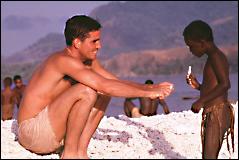![[Deep Focus]](../../flicker/logo.gif) |
|
|
THE THIN RED LINE | |
 |
GRADE: A- | With the natives. |
|
Every review of The Thin Red Line that you read is likely to note that Terrence Malick, the Thomas Pynchon of American cinema, has been on a sabbattical from filmmaking for two decades, since Days of Heaven in 1978. Rightly so -- that's a crucial bit of information for you to have as you settle into that theater seat. Once the lights go down, you're in Malick's world. It's as though the last 20 years of Hollywood filmmaking never happened. The Thin Red Line may not be sui generis, but it is more or less without precedent in recent history. The obvious reference point is 1979's Apocalypse Now, which shares The Thin Red Line's distended narrative style as well as Malick's penchant for lustrous images emerging from an ink-black cinema screen. Both pictures are war movies for which the setting of a real war is largely incidental to the psychological implications of participating in war. They're about states of mind, about the impact of mad violence on the psyche, and about a man's capacity for poetic feeling even in a time of war. In the first reel of The Thin Red Line, Malick sets up his ground rules, and what's amazing is how effortlessly he plays the game. The dominant device is the interior monologue, and Malick shuffles it from soldier to soldier at regular intervals. These rhapsodies in voiceover ("How did we lose the good that was given us?") irritate viewers who find it downright irrational that soldiers under pressure would be so damn delicate, but the difference between (to make the obvious comparison) Saving Private Ryan and The Thin Red Line is the difference between a film that strives for realism and one that investigates impressionism. I don't mean to shortchange the storytelling craft on display here, which is astounding. The film's centerpiece is an hour-long skirmish in the battles of Guadalcanal, in which Charlie Company takes an enemy encampment atop a grassy hill. Racked with tension, dread, and agonizing detail, it ranks with the Normandy sequence from Saving Private Ryan as a showcase intersection of cinematic art with moviemaking technology. Things really shift into gear when the camera comes unmoored, gliding easily above the blades of tall grass. As the American soldiers creep forward, it remains jarring when the screen explodes in gunfire and shrapnel. Malick and cinematographer John Toll shoot this in a way that makes us feel trapped with the soldiers, singleminded in a mission that identifies only an enemy to be overcome. So when he starts cutting in little POV shots from inside the enemy bunker, behind the machine guns, it's unnerving. And when those enemy soldiers start running into frame, their bodies jerking and flailing as they're shot down by our American protagonists, it's downright terrifying. Through all of this, the camera keeps pushing forward, finally tracking slowly through a ramshackle camp full of wounded, forlorn Japanese soldiers. It may be that we're meant to see them, the losers in the battle, as pathetic doppelgangers of the Americans. The film comes unglued at about the two-hour mark, allowing its elusive narrative center to drift and dissipate. Still, even that last section is riddled with beautiful images and tiny epiphanies. It was the film's presence and immediacy that startled me time and again -- for most of the film, Malick did the damnedest job of putting me there in the tall grass, asking myself what it all meant and trading words with the philospher inside. For all its skill in evoking a time and place far removed from any viewer's everyday experience, The Thin Red Line takes place inside your head. | |
|
Directed by Terrence Malick Written by Malick, based on the novel by James Jones Cinematography by John Toll Edited by Leslie Jones, Saar Klein, and Billy Weber Music by Hans Zimmer Starring Jim Caveziel, Ben Chaplin, Nick Nolte, and Sean Penn Theatrical aspect ratio: 2.35:1 USA, 1998
| |

| |
 http://www.deep-focus.com/dfweblog/
bryant@deep-focus.com
http://www.deep-focus.com/dfweblog/
bryant@deep-focus.com